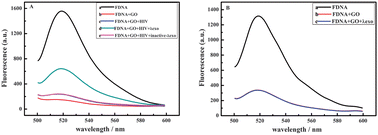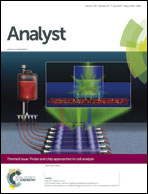An enzyme-aided amplification strategy for sensitive detection of DNA utilizing graphene oxide (GO) as a fluorescence quencher†
Abstract
A facile, sensitive and rapid method has been developed for detection of disease-related DNA based on lambda exonuclease-aided signal amplification by utilizing graphene oxide (GO) as a fluorescence quencher. The fluorescence of the carboxyfluorescein-labeled DNA probe (F-DNA) was sharply quenched due to the electron or energy transfer between the fluorescence dye and GO. While in the presence of target DNA, the formation of a DNA hybrid released F-DNA from the surface of GO, leading to a fluorescence recovery. Then, the fluorescence enhancement was further amplified by using lambda exonuclease (λexo) to liberate target DNA for cyclic hybridization. Fluorescence polarization and gel electrophoresis further verified the reliability of the principle. Disease-related DNA can be sensitively detected based on the enzyme-aided amplification strategy. More importantly, single-base mismatched DNA can be effectively discriminated from complementary target DNA and random DNA. Therefore, it offered a universal, simple, sensitive and specific method for detection of disease-related genes.


 Please wait while we load your content...
Please wait while we load your content...